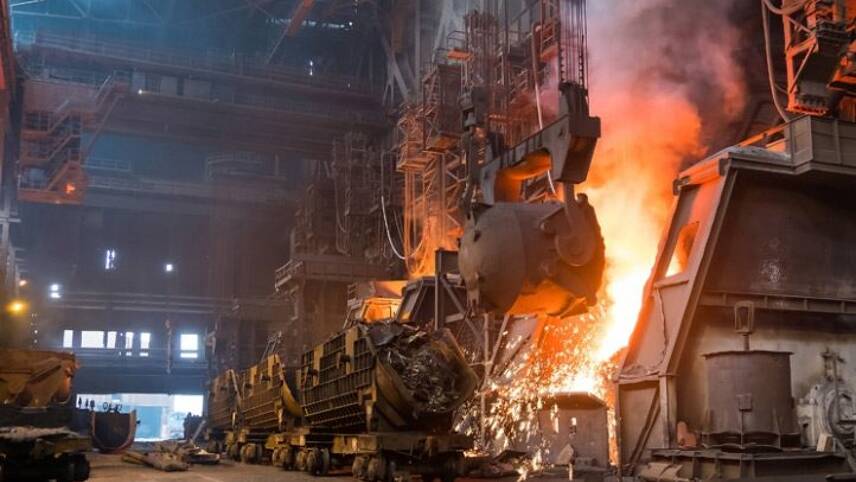Register for free and continue reading
Join our growing army of changemakers and get unlimited access to our premium content

Image: ArcelorMittal Europe
ArcelorMittal Europe announced its new climate roadmap at an online event this morning (25 June), outlining the two key ways in which it will decarbonise its steelmaking processes.
The first of these methods is called Smart Carbon. The process involves replacing virgin carbon, which becomes embodied in the steel, with “circular” carbon, captured from other industrial processes or energy generation. Electricity used throughout the manufacturing process is 100% renewable. As for heat – a major contributor to the steel sector’s carbon footprint – the Smart Carbon process can be achieved at lower temperatures. Carbon capture and storage (CCS) is then used to prevent residual emissions.
ArcelorMittal Europe is also investing heavily in low-carbon systems for producing direct reduced iron (DRI). DRI does help to give a new life to low-value or hard-to-recycle scrap, but is usually produced using heat from coal or natural gas, so the firm is adapting its infrastructure to accommodate hydrogen and other alternative fuels. Hydrogen is not a green solution in and of itself – 95% of the hydrogen produced globally in 2018 was produced using fossil fuels. However, the global green hydrogen sector is set for rapid expansion in the coming decades, as technology costs fall in line with changing policies, economies of scale and growing corporate demand.
Away from these two methods of steelmaking, ArcelorMittal has committed to exploring the potential of bioenergy produced using waste materials from agriculture or from forestry products certified as sustainably sourced.
The firm said in a statement that it expects the majority of technologies outlined in its plans to be ready for commercial-scale use by 2025, meaning that, by the early 2030s, Smart Carbon systems will be either installed or in development at most of ArcelorMittal Europe’s facilities.
But it is also calling for additional policy support to ensure that this trajectory is realised through the EU’s Green Deal and its Covid-19 recovery package – a €750bn fund with, in terms of the green economy, significant provisions for low-carbon transport, building renovation and renewable energy generation.
ArcelorMittal Europe specifically wants stronger measures for helping steelmakers access sustainable finance to invest in long-term innovation; for scaling up not only renewable energy generation but improving supporting infrastructure; and for making a Carbon Border Adjustment to prevent imported, high-carbon steel from undercutting locally-produced, low-carbon alternatives.
“Today, the biggest barrier to transitioning to carbon-neutral steel, beyond the necessary technologies reaching commercial maturity, is the absence of the right market conditions,” ArcelorMittal Europe’s chief executive for flat products, Geert Van Poelvoorde, said. “The financial costs of realising carbon-neutral steelmaking are undeniably huge. However, with a shift in market conditions brought about by having the right policies in place, European steelmakers will be able to unlock the means to reduce emissions from steel globally, while also ensuring the European steel industry remains competitive.”
The firm’s roadmap and demands come one year after it first vowed to develop a pathway to net-zero emissions by 2050. In December 2019, ArcelorMittal Europe’s medium-term aim to reduce Scope 1 and Scope 2 emissions by 30% by 2030, against a 2018 baseline, were approved as science-based.
On target
In related news, multinational ICT services and consulting firm Atos has this week unveiled a 2035 net-zero target, which it claims is the most ambitious in its sector.
The target is bolstered by a 2025 ambition to halve emissions across all scopes, against a 2018 baseline. Shifting to renewable energy and investing in energy efficiency in both direct operations and the supply chain will deliver the majority of this reduction, Atos said in its latest integrated report.
Atos has notably been investing in certified carbon credit programmes to offset residual emissions across Scope 1 (direct) and Scope 2 (power-related) sources since 2017. The credits are split equally between those that invest in renewable energy and those that invest in nature restoration.
But there are numerous controversies around offsetting and, as such, most businesses see them as part of the transition to net-zero, rather than a “silver bullet” solution.
Atos’ chief executive Elie Girard said the new decarbonisation targets “mark a new step forward” in the firm’s mission to “pioneer decarbonization for the benefit of its customers, all its stakeholders and society at large, by transforming the way digital technologies are designed, developed and used.”
Atos had previously signed the ‘Business Ambition for 1.5C’ pledge, orchestrated by the UN Global Compact and We Mean Business Coalition. It is also a member of Defra’s E-sustainability Alliance, a coalition of businesses, NGOs and policymakers working to minimise the environmental impact of the ICT sector and empower non-ICT businesses to use digital technologies to drive their own transitions to low-carbon, resource-efficient, socially-equitable models.
Sarah George


Please login or Register to leave a comment.